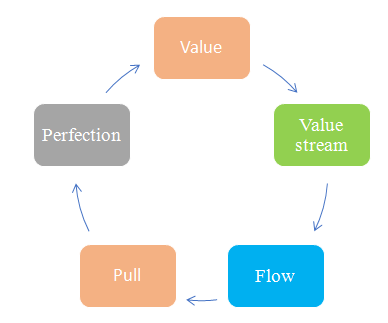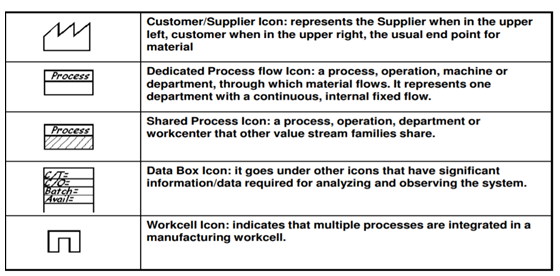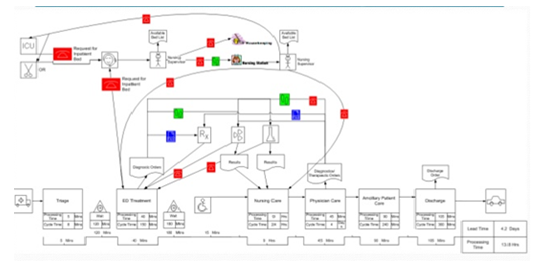Critical System Thinking Assignment Help
Scenario
Overview:
Consider yourself as part of a team responsible for managing the operations of an emergency department of a public hospital. The emergency department has received feedback from patients suggesting that the patient wait times need to be improved. The value stream map of the current operations is shown in the attached diagram:
Value Stream Map
You have been tasked with improving patient turnaround time by reducing the current time to half. To complete the task you are required to identify the various System Archetypes that affect the operations of the hospital and the emergency department itself and based on the archetypes, develop a future State Value Stream Map of the emergency department. It is recommended that you identify and critically analyse intended and unintended consequences, recommending holistic solutions that will optimise the operations of the emergency department without compromising the performance of other functions of the hospital.
24/7 Availability of Trusted Critical System Thinking Assignment Help solution Writers! Order Assignments for Better results!
Critical System Thinking
Introduction
The emergency department of a hospital is driven to fulfil the primary goal of serving quality services to its customers. To enforce this objective the hospital management has to engage the staff in effective operations management to produce the desired outcomes. Operations management uses certain tools such as the service package, the service process, management tools, and quality management tools. The report deals with the case study of an emergency room which has a primary drawback of keeping the patients waiting for a longer time span. The hospital follows a particular value stream map to manage the operations of the emergency department. The report aims to analyse various models which can be implemented in the workings of the emergency department to decrease the waiting time of the patient without degrading the quality of services provided by them. In the latter part of the report includes some recommendations to improve the value stream mapping to speed up the operations of the staff.
Analysis
Identification and analysis of the system archetypes which impede performance standard
The system archetypes are effective tools to evaluate the behavioural pattern and reflective structure of the organisational infrastructure. Archetype systems can be applied in two separate aspects which include diagnostic application and prospective application. Both types of application are utilised to measure the performance standard of the staff and their departments. Archetypes systems can be utilised to improve the existing system of the emergency room, performance standard and information flow of hospital. The efficiency of archetypes lays in a basic remedial structure which is utilised to develop a foundation. Archetypes generally find a common way to look into the behavioural outcome of organisations. There are eight types of archetypes which can be effective to impede the performance standard (Winkel et al., 2015). The types are Limits to growth, shifting the burden, eroding goals, escalation, success to the successful, tragedy of commons, fixing the fails and growth and underinvestment. Archetypes can be implemented to develop diagnostic prospectively. The principles can be used to examine problems and ways to deal with it. Moreover, the principles of prospective archetypes can be used for the betterment of the treatment process.
Limits to growth
Limits to growth evaluate that several factors always try to limit the growth of positive reinforcing behaviour. For example- limiting growth is capable to evaluate limitations of performance growth of the emergency department of a hospital.
Dynamic theory
In the dynamic theory, archetypes determine the reinforcement of accelerating growth. It determines the growth of external factors which increases the limitations of the behavioural process. The continual efforts of growth acceleration diminish return as a limiting approach. Identified limitations of handling healthcare emergency can be successfully achieved by
• Focusing on the fundamental situations: The focus on fundamental situations can be monitored by providing a symptomatic solution. In this case, the situation of the emergency room and the patient's waiting time can be provided with an indirect or indicative solution for emergency handling through briefing the staff regarding the average time a patient has to wait at the emergency room and also by explaining them the importance of reducing the time span of the wait.
• Eliciting multiple viewpoints: eliciting multiple viewpoints differentiates fundamental symptoms and symptomatic solutions. In the scenario, the undeveloped situation of the emergency room including patients' waiting time can be observed by depicting the fundamental symptoms responsible for the delay.
• Using advanced archetypes: The use of advance archetype can be utilised to address the side effects. As per the given scenario, the possible impact of improving the process for patient waiting in the emergency room can be evaluated by this process such as lack of staff in other departments, poor performance outcome etc. (Henrique et al., 2016).
However, the ‘limits to growth' model is a time-consuming improvement process. This aspect of archetype cannot be adopted for quick improvement.
Eroding goals
Eroding goals is a shift of burden and tension between the symptomatic solutions. In this case, managers force their employees to develop their performance which ultimately fails. A rational change in the objectives is the ultimate goal of this archetype aspect. Linking with the scenario, it can be stated that the emergency department of the hospital cannot be improved forcefully as it may not maintain the required quality. A steady and effective step can be beneficial to improve existing situations of eroding goals (Bal et al., 2017).
Escalation
Escalation archetype is irony management which escalates harmful behaviour and reduce consumer satisfaction. As per the given scenario, the patient waiting time in the emergency department must be improved along with fulfilling all other requirements such as, development of hospital records, attending nurses and attending physicians. Thus, the escalation process cannot be utilised to improve standing situations of the emergency departments.
Success to the successful
Success to the successful archetype depicts the common practices which can be utilised to develop performance level through the reward and recognition process. Moreover, this archetype requires sufficient resources o improve its existing performance level. Improvement of existing performance depends on the capabilities of organisational staffs to utilise resources. The value of success to successful archetype is to raise questions regarding previous performance gaps. The questions on previous performance gap help to reduce the performance hazards which can be beneficial for overall performance development (Kingsnorth et al., 2015). Hence, in the emergency department of the hospital, the patient waiting time should be improved by evaluating previous performance gaps of the emergency department and its staff. This archetype can be utilised to improve the waiting time in the emergency department. However, this archetype is time-consuming and requires a detailed analysis of the previous performance records (Nallusamy, 2016).
Tragedy of commons
A tragedy of commons is a set of organisational resources which includes human resources, materialistic resources and tools resources. This archetype focuses on team sharing to satisfy the goals and objectives set for each team. Expectations and demands for common departments increase with the expansion of the team and its individuals. Teams do not have sufficient awareness regarding the increase of demand from the consumers (De Steur et al., 2016). Thus, the sharing of information among common departments and resources is essential to improve the situation of the emergency department of the hospital. Moreover, the Tragedy of Commons is helpful in evaluating reductionist thinking. It determines the adverse impact of unawareness about the information among the team members. Information can be shared by evaluating quality care in the emergency department, recording improvement levels of each patient, number of times nurses attend patients, the capability of nurses in providing medical supplies and ways through which doctors take care of patients. The tragedy of common archetypes can be adapted to impede the performance (Provost et al., 2015).
Fixes and fails
Fixes and fails can be stated as an updated version of the shifting of the burden. This type of archetype evaluates that managerial symptoms and should be primarily evaluated to identify issues rather than finding difficulties in all the problems associated with the system. The consequences of fix and fails are an unintended quick fix all functions of problem symptoms (Chandler et al., 2016). This model also evaluates the adverse situations created after the application of the fixing strategy. The current scenario of emergency department cannot be improved by fix and fails as this archetype does not provide any solution to issues.
Growth and underinvestment
Growth and underinvestment archetype limits growth by evaluating the need for investments in resources. It follows a process of growing action, current demand, current performance evaluation, and requirement of investment, the capacity of investment capacity to grow. Apart from that, a performance standard can also be included in the stage requirement of investment. Growth and underinvestment focus on the long-term requirement and core competency for competitive development. This archetype cannot be adopted to improve the patient waiting time as this focuses on the external development instead of internal infrastructure development (Rani et al., 2018).
Recommended new state value stream map reducing the turnaround time
The value stream model is a flow chart which evaluates the flow of inventory and information system of an organisation. Purposes of developing new value stream mapping are as follows:
• To develop an effective design to provide information to target consumers
• Building a stream mapping to increase efficiency in the order to delivery process
• To keep sustainability through the effective use of life cycle
Existing value chain map of the hospital was hazardous as there was no equivalent spreading of information amongst the teams (Dako et al., 2018). This was the ultimate reason for the improvement of patient wait times.
Steps to improve value chain mapping are Current state, future state and next future state. The required principles to improve value stream mapping is as follows:
• Specification of the value from consumers' end
• Identification of value stream for each emergency medical service
• Making of service flow
• Pulling the flow from consumers' end
• Perfection management

Figure: Value stream map
Source: Created by Researcher
The value stream map focuses on the value expectations which include price determination, quality determination, and determination of reliability and response to change. Symbols play effective roles in developing value streaming map. For example- some symbol indicates the consumer or supplier, some symbol indicates process flow and some symbol indicates work cell icon.

Figure: Value stream mapping symbol
The future value stream mapping for developing the emergency department and for improving information flow should be free from operational hazards. Moreover, it must improve the existing situation of the emergency room. The proposed value stream map should be as below:

Figure: Proposed value stream map
Source: Matharu, 2012
The value stream map for emergency room of the hospital is helpful in allowing ‘‘ITEMS'' flow. It defines:
• Development and designing of proposed value stream map
• Understanding of internal consumers' need
• Understanding of external consumers' need
Hence, development of a value stream map is capable to provide a proper infrastructure for the patients' wait time. The development of infrastructure can improve existing situations of an emergency room. The improvements must be localised to analyse strengths, visions and plans of improvement activities (Haynes, 2015). A value stream mapping can be considered as an effective tool to address the operational issues and propose changes for issues (Wysocki, 2004).
Intended and unintended consequences of the system
As per the given scenario, unintended consequences evaluate the efficiency of the archetype system to develop emergency room. The unintended consequences of the various type of archetype system are as follows:
? Fixes that fail is quickly fixed into motion and ends up adding some more issues and symptoms
? Shifting the burden has developed side effects by harming the initial system solution
? Limits to success slow the growth of performance standard
? Eroding goals declines the system performance
? Growth and underinvestment slows the demand validating
? Success to successful allocates resources disproportionately
? Escalation archetype escalates retaliation
? Tragedy of commons shuts down the activities of all parties
Recommendations
Recommending actions to develop archetype system of hospital emergency room for better consumer experience are as follows:
? Potential limits and balancing scoops should be identified to develop limits to growth
? All the quick fixes should be mapped properly to keep issues under control
? A clear transition plan should be developed to influence performance in eroding goals
? Escalation trap must be avoided by building a collaborative competition
? Performance gaps must be scanned at a regular interval
? In the case of the tragedy of commons, all the central focal points must be determined by sharing visions, measuring systems and allocating resource base needs
? Potential side effects for intervention plans must be mapped properly
? A diversified investment input must be searched to seek new perspectives of products and services.
Conclusion
The public hospital is dealing with the main issue of the longer waiting time of patients in the emergency department. This issue is hampering the image of the hospital. So, the hospital authorities are willing to bring in some reforms to reduce the waiting time without bringing down the quality. The report analysis various models such as the dynamic theory, fixes and fails and so on to understand their suitability to solve the issues of the hospital. a critical analysis of the current value stream map has also been provided along with some recommendations to deal with the issues.
Get assured A++ grade in each Critical System Thinking Assignment Help order – Order for originally written solutions!